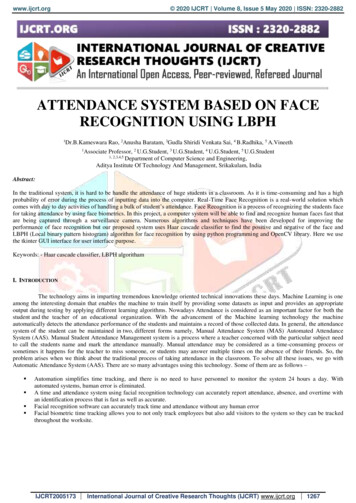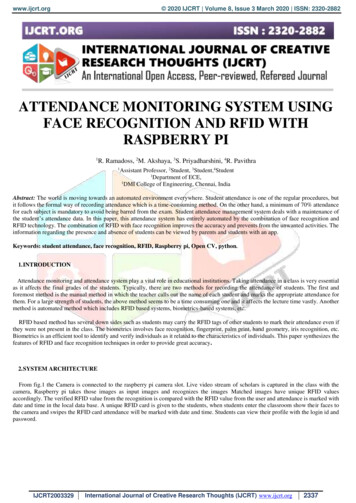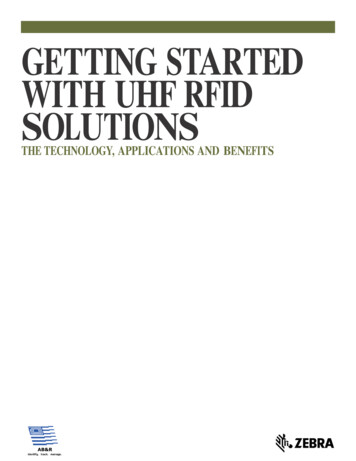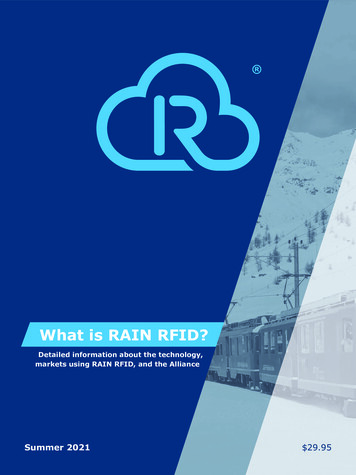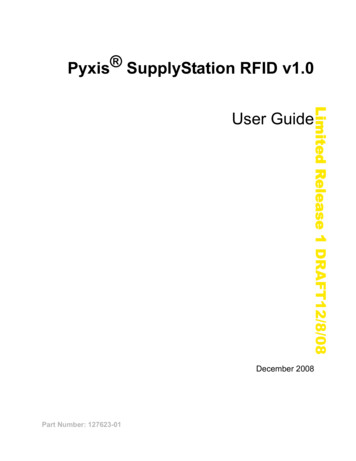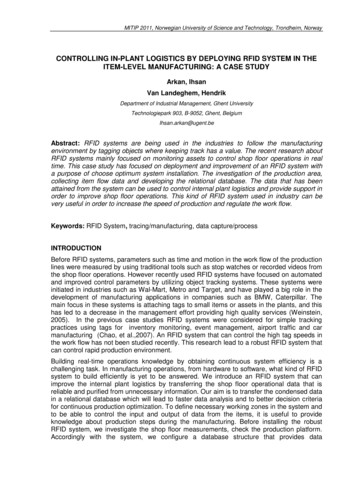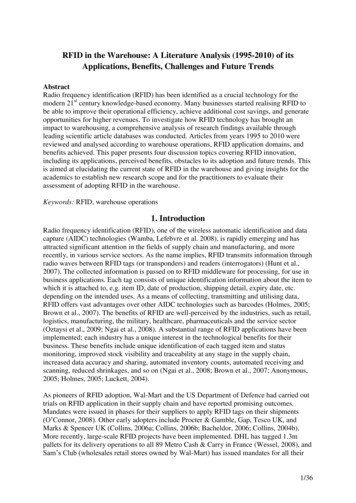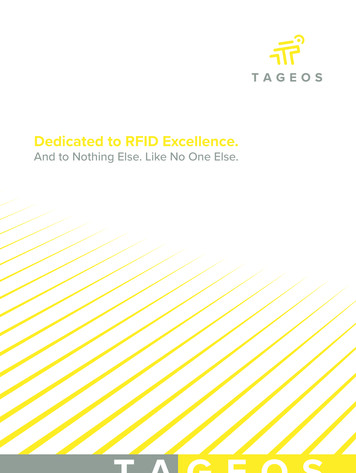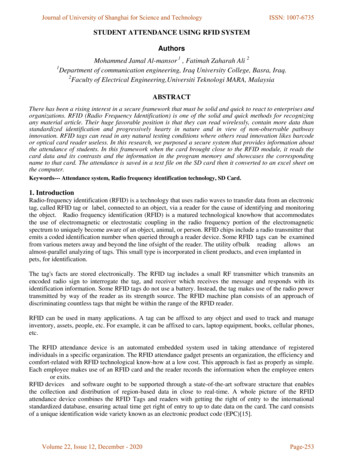
Transcription
Journal of University of Shanghai for Science and TechnologyISSN: 1007-6735STUDENT ATTENDANCE USING RFID SYSTEMAuthorsMohammed Jamal Al-mansor 1 , Fatimah Zaharah Ali 21Department of communication engineering, Iraq University College, Basra, Iraq.2Faculty of Electrical Engineering,Universiti Teknologi MARA, MalaysiaABSTRACTThere has been a rising interest in a secure framework that must be solid and quick to react to enterprises andorganizations. RFID (Radio Frequency Identification) is one of the solid and quick methods for recognizingany material article. Their huge favorable position is that they can read wirelessly, contain more data thanstandardized identification and progressively hearty in nature and in view of non-observable pathwayinnovation. RFID tags can read in any natural testing conditions where others read innovation likes barcodeor optical card reader useless. In this research, we purposed a secure system that provides information aboutthe attendance of students. In this framework when the card brought close to the RFID module, it reads thecard data and its contrasts and the information in the program memory and showcases the correspondingname to that card. The attendance is saved in a text file on the SD card then it converted to an excel sheet onthe computer.Keywords--- Attendance system, Radio frequency identification technology, SD Card.1. IntroductionRadio-frequency identification (RFID) is a technology that uses radio waves to transfer data from an electronictag, called RFID tag or label, connected to an object, via a reader for the cause of identifying and monitoringthe object. Radio frequency identification (RFID) is a matured technological knowhow that accommodatesthe use of electromagnetic or electrostatic coupling in the radio frequency portion of the electromagneticspectrum to uniquely become aware of an object, animal, or person. RFID chips include a radio transmitter thatemits a coded identification number when queried through a reader device. Some RFID tags can be examinedfrom various meters away and beyond the line of sight of the reader. The utility of bulk reading allows analmost-parallel analyzing of tags. This small type is incorporated in client products, and even implanted inpets, for identification.The tag's facts are stored electronically. The RFID tag includes a small RF transmitter which transmits anencoded radio sign to interrogate the tag, and receiver which receives the message and responds with itsidentification information. Some RFID tags do not use a battery. Instead, the tag makes use of the radio powertransmitted by way of the reader as its strength source. The RFID machine plan consists of an approach ofdiscriminating countless tags that might be within the range of the RFID reader.RFID can be used in many applications. A tag can be affixed to any object and used to track and manageinventory, assets, people, etc. For example, it can be affixed to cars, laptop equipment, books, cellular phones,etc.The RFID attendance device is an automated embedded system used in taking attendance of registeredindividuals in a specific organization. The RFID attendance gadget presents an organization, the efficiency andcomfort-related with RFID technological know-how at a low cost. This approach is fast as properly as simple.Each employee makes use of an RFID card and the reader records the information when the employee entersor exits.RFID devices and software ought to be supported through a state-of-the-art software structure that enablesthe collection and distribution of region-based data in close to real-time. A whole picture of the RFIDattendance device combines the RFID Tags and readers with getting the right of entry to the internationalstandardized database, ensuring actual time get right of entry to up to date data on the card. The card consistsof a unique identification wide variety known as an electronic product code (EPC)[15].Volume 22, Issue 12, December - 2020Page-253
Journal of University of Shanghai for Science and TechnologyISSN: 1007-6735Nowadays, there are loads of groups around the world and some of them consist of employees up to 10thousand or more. To manage a large variety of employees might also be a hassle especially to get theattendance of the workers.The guide process ability that whenever a worker comes to work, he goes to sign at the time officer‟s table.This guided process has some flaws due to the fact in a case the place a worker bribes the time officer or isacquainted with him, the time officer might also tamper with the attendance records. This would be a hugeproblem in the company and may affect the productivity and administration of the enterprise the appropriateanswer for this trouble is with the aid of designing a gadget that will record attendance automatically. In thisresearch, RFID gadget is used to report the numbers of employees‟ attendance automatically. The ID cardsof the personnel is embedded with RFID tag which is read through a reader. This RFID gadget isinterfaced to a database thru a computer. This approach is nicer to forestall hassle encountered when gettingattendance manually.These problems can be listed in several formats as per below:oEnergy loss of professors: Each professor should check attendance of about 25 to 30students per session and thus his energy is wasted.oLoss of time useful for teaching: Students attendance is naturally associated with the timeand spending this time leads to a waste of time that is useful for teaching.oMisuse of list to change the absence of a student to attendance: In some cases, it isobserved that students ask professors frequently to change their status from absence topresence.oThe possibility of missing list: Its students‟ right to be behaved in justice regarding thepresence and absence. It is not possible in case of loss or lack of list [13].2. Literature Survey[3]Have implemented a system called RFID Based Automatic Attendance systems. This attendance systemsoftware has been developed using VB.net and database (Microsoft Access). Each student has RFID tagattached with their Student ID card. There is a serial connection amid computer and RFID reader also has beenmaintained for connection between RFID and the computer system. The RFID reader is placed at the lecturehall door. Whenever students enter the lecture hall RFID reader read the RFID tag and it store the allinformation (Entry time, Name, etc.) of students into database via serial connection and maintain the system.Here admin of this system can view all documents using the software interface by retrieving information fromdatabase without any difficulties not like traditional system.[4] Implemented an attendance system with the combination of RFID and Web-Based system. This systemuses a RFID tag and reader for getting students‟ attendance and read particular student. Then this readerconnects with Arduino microcontroller which passes the RFID reader response to web server by using Arduinoshield, finally the attendance of students can be stored in web server by using PHP and MySQL. The admin ofthe system can view all students‟ documents by login to this particularWeb based application and also can view the student‟s details using LCD displays.Found a system that, RFID and Pose Invariant Face Verification for automatic attendance system. This systemworks under two-factor verifications. In the first step, students need to use RFID tag which is read by RFIDreader. If the first step is succeeded then it moves to second step of verification, if not, student becomes underunrecognized category. The second step is Face verification, if the face match with particular RFID tag then itmarks attendance into database. Missing the above both readings, the system identifies the fraud students. Thistwo-factor automatic system reduces the misuse of identity theft for the purpose of getting attendance [5].Volume 22, Issue 12, December - 2020Page-254
Journal of University of Shanghai for Science and TechnologyISSN: 1007-6735“Arduino Based Smart RFID Security and Attendance System with Audio Acknowledgement” is developed byYashi Mishra et al. SD card module with RFID tag which carry different voice codes is used in this system.The tag ID and code of the voice greeting stored in SD card module. While a student enters the class roomdoor, his / her RFID tag is being read. If the ID of the tag matched with stored data in the SD card thenparticular person needs to use the voice greeting, if it is matched then the door will be opened and theattendance will store in excel sheet. Student can view the attendance detail using the LCD placed in Arduino.Here Arduino working as microcontroller to connect LCD, RFID reader, SD card module and so on. Thissystem is also working as two-factor verification process. Moreover, this system is very simple schematicsthan other system because of very simple components and design. Also here we get fast response withaccuracy [7].[8] Had been created a prototype system called Microcontroller Based Attendance System Using RFID andGSM. This system consists three atMega16 microcontroller placed in between RFID reader, GSM modem andcomputer. Each microcontroller has its own purpose. The system starts whenever a teacher used his/her RFIDtag to enter the class room and students will enter the class room by swapping their tag within five minutes.RFID reader reads RFID tag and sends the signal to first microcontroller which analyses the signal of RFIDreader and opens class room door using IR signal which is influenced by a motor. The signal is temporarilystored in microcontroller, when teacher finishes his / her class he /she must swap the RFID tag again to thereader and system decides automatically that the class is over. Thus, microcontroller passes the temporarystored signal to computer database as attendance. In case of absent of student, the signal passes to GSMmodem and it will send the message to parents of the students who were not at the class. If any students go outbefore teacher use finishing RFID tag which doesn‟t count the status (present) of the students. This systemitself added advanced and reliable security features.Thus students are not able to cheat the administration and parents [8].Proposed a system that working with RFID and GSM. Here they have used microcontroller (LPC) as anintermediate amid GSM module and RFID. Whenever students enter the classroom, they need to use their tagwhich read by RFID reader and it send to the present signal to GSM module. If the ID of the tag does notmatch with database it considered as unauthorized access. If it is okay then GSM module send massageadministration and parents. [9].[10] Proposed a system that web based attendance using four-tier architecture by using RFID and Biometrics.In this system student‟s and teacher‟s RFID unique code will store into the database. A RFID reader andfingerprint device are placed at the door of the classroom. When students enter classroom, they need to use theRFID tag which read by reader and verifies identify by comparing with database whether the tag matches ornot. Second level verification will be allowed if and only if first level is succeeded. Verification withfingerprint is the second step of the system and if the student‟s finger print matches with database then theattendance will be marked and stored into database, if not there is no attendance for students. The fingerprintverification only active in span of ten minutes including five minutes before the schedule and after theschedule of class starting time. If anyone late then it denies to provide attendance to particular student butstudents can stay at the lectures and learn. Finally, SMS will send to the student‟s parents about informparticular students‟ presence. This system is time oriented.[11] Developed a prototype for attendance management system with the placement of a greater number ofRFID readers placed in room and there is a server application maintains via a laptop. The reader and laptop orPC connected with the help of wireless router or LAN connection. When a person enters the room, he / sheneeds to use the RFID tag which reads by RFID reader and passes the attendance to the server through wirelessor LAN connection. Since many RFID readers are placed, more than one person can get the attendancesimultaneously and get the higher efficiency than traditional method.Also, [12] suggested a system that working with RFID and Telegram Messenger Application. In this systemstudents are needed to meet the teachers for tapping of RFID tags. If it is matched with tag stored in thedatabase, then it sends to the attendance to the principal in the form of excel as well as it sends a message tothe specific student‟s parent via Telegram messenger.Volume 22, Issue 12, December - 2020Page-255
Journal of University of Shanghai for Science and Technology3.ISSN: 1007-6735SYSTEM DESIGNRFID based Automated Student Attendance system is a highly specialized system that automate the wholesystem of students‟ attendance registration using RFID. The major factors in designing a RFID attendancesystem include: choosing the hardware and software components and integrating both to work together,defining the system working mode (verification or identification) and defining administration and optimizationpolicy [14,16]. Student attendance system framework is divided into three parts: Hardware design, Softwaredesign, Attendance Management Approach and Report Generation. Each of these is explained below.4.HARDWARE DESIGN4.1 MICROCONTROLLER PIC18F452The controller used in this project is a 40 pin wide DIP (Dual In Line) package chip named PIC18F452; Thischip was selected because it is robust, and the DIP package interfaces with prototyping. Supplies like solderless bread boards and solder-type per-boards. This same microcontroller is available in a surface mountpackage, about the size of a dime. Surface mount devices are more useful for circuit boards built for massproduction. Figure 1 below shows the „pin-out‟ diagram of the PIC18F452. This diagram is very useful,because it tells you where power and ground should be connected, which pins tie to which functionalhardware, etc.Figure 1: Pin Diagram of PIC18F452Volume 22, Issue 12, December - 2020Page-256
Journal of University of Shanghai for Science and Technology4.2ISSN: 1007-6735LCD DISPLAYThe display support 4X20 characters, which means, the LCD can support 4 lines on the display and each linecan display up to 20 characters which is relevant as the only essential output to be displayed is the student‟sname, metric no., gender and ID. Besides LCD Display, the output is displayed on LCD. The diagram of LCDdisplay is shown in Figure 2 belowFig 2: Circuit Diagram of LCD Display4.3RFID READERA reader (now more typically referred to as an RFID interrogator) is basically a radio frequency (RF)transmitter and receiver, controlled by a microprocessor or digital signal processor. The reader, using anattached antenna, captures data from tags, then passes the data to the controller for processing. The readerdecodes the data encoded in the tags integrated circuit (silicon chip) and the data is passed to themicrocontroller for process.FEATURES OF RFID READERa. Low cost solution for reading passive RFID transponder tags.b. Industrial grade casing for better outlook and protection.c. Integrated RFID reader, antenna, LED, power cable and data cable.d. Every reader has been tested before is being shipped.e. 9600 baud RS232 serial interface (output only) to PC.f. Fully operation with 5VDC power supply.g. Buzzer as sound indication of activity.h. Bi-colour LED for visual indication of activity.i. Standard RS232 serial cable (female) ready to plug to desktop PC or Laptop.j. 2m reading range.k. 0.1s response time.l. Operating frequency: 125KHz5.Project FlowA particular methodology of executing is required in this undertaking like some other programmingequipment incorporated task. This methodology underlines on well-ordered advancement bycompleting one stage before progressing to the next until it achieves the last phases of prototyping.Figure 3 demonstrates the task stream diagram.Volume 22, Issue 12, December - 2020Page-257
Journal of University of Shanghai for Science and TechnologyISSN: 1007-6735Figure. 3: Project Flow Chart5.1.HARDWARE ARCHITECTUREThe system hardware is based on a Atmega2560 microcontroller. This microcontroller has 256 KB ofwhich 8 KB used by boot loade Flash program memory & 8KB Static Random Access Memory(SRAM). The entire hardware can be divided into four parts like Liquid Cristal Display (LCD)display interface section, RFID module interface section, real time clock interface section and SDCard interface section. All these sections are controlled by the ATmega2560 microcontroller and therequired software to control the sections are Arduino Integrated Development Environment (IDE).5.2.CONNECT THE COMPPNNENTSWe adopted the project on a pair of processors (Arduino Ono) the research therefore divided into twoparts.In the first, part (Arduino A) the following parts connectedRFID RC522:3.3v PIN 3.3vRST PIN 9GND GND PINMISO PIN 12MOSI PIN 11SCL PIN 13SDA PIN 10Volume 22, Issue 12, December - 2020Page-258
Journal of University of Shanghai for Science and TechnologyRTC:ISSN: 1007-6735VCC PIN 5VGND GND PINSDA PIN A4SCL PIN A5BUZZER:Positive side to pinThe negative side to GNDIn the second, part (Arduino B) ,The following parts are connected.SD CARD MUDLE:SCL PIN 13MOSI PIN 11MISO PIN 12VCC PIN 5VGND GND PINCS PIN 4LCD SCREEN:VSS GND PINVDD 5V PINV0 GND PINRS PIN 10RW GND PINE PIN 9D4 PIN 8D5 PIN 7D6 PIN 6D7 PIN 5A 5VK GNDVolume 22, Issue 12, December - 2020Page-259
Journal of University of Shanghai for Science and TechnologyISSN: 1007-6735Figure 4: Connection Circuit6. Implementation:In this chapter, the results will be displayed in detail starting from the RFID tag reading until theyare stored and displayed in the computer. The name of the person identified within the Arduino andcorresponding to each card (which was previously programmed and assigned a name for each Tag)will be displayed on the LCD screen when reading the RFID Tag and at the same time it will be storedin a TXT file on the SD And then the information will be dragged to the Excel file to be displayed onthe computer screen. These steps will be explained more clearly in the next paragraphs.6.1. RFID Tag ReadingBefore starting to mention the details of reading the RFID Tag, we would like to mention that a handand a button have been added. When you place any Tag on the RFID reader, a flash is issued by theLED, plus a voice from the buzzer at the same moment as a signal The RFID Tag has been read.In the following figures we will review the RFID read information where five tags were programmedand read by the department and take a picture of the information that appears when reading the Tag.Starting with Figure 5 that shows the moment of the tag readers associated with the name "Tareq"Figure 5: record the attendance of the 1st studentVolume 22, Issue 12, December - 2020Page-260
Journal of University of Shanghai for Science and TechnologyISSN: 1007-6735Note from the Figure 4-1 that the information that will appear is the student's name and date and theright part of the student's name is programmed, while the left part is for the date.Let's now move on to the second Tag test and pass it on to the reader and take a picture of theinformation that appears on the LCD.As shown in Figure 6 shows us the second name that was established for this Tag, which is "ali".Figure 6: record the attendance of the 2nd student6.2. Data Sheet of Recorded Attendance at TXT FormatAfter the recording of the event, which was stored by the Arduino as a TXT file on the SD RAM,the RAM is inserted by ADAPTER into the computer. The information stored in the table is shown infigure 7. The table consists of three fields : the first represents the name, the second represents Thedate of attendance and the third represents the time of attendanceFigure 7.Attendance stored as TXT file within SD RAMVolume 22, Issue 12, December - 2020Page-261
Journal of University of Shanghai for Science and TechnologyISSN: 1007-6735Figure 8: Data Sheet of Attendance as Excel FormatHere is the last step, which involves transferring the information stored on the TXT file to an Excelspreadsheet on the computer for the purpose of conducting statistics on attendance of students. Figure9 shows the Excel file obtainedFigure 9: Attendance as an Excel file7.ConclusionThe system is a low cost system which is designed to withstand any terrain and surrounding, providingtactical and surveillance and better comfort. Moreover, the Arduino board allows the system install inmore simple way. RFID technology positively promises an increased effectiveness and improvedefficiency for business and administrative processes. All the future work is expected without spendextra cost, even one cent from the current system.Volume 22, Issue 12, December - 2020Page-262
Journal of University of Shanghai for Science and Technology8.ISSN: 1007-6735Future WorksThis study is considered the basic phase for several future types of research and the following operationscan be carried out to improve the performance of this algorithm: Make a wireless connection between Arduino and pc Design an online database attendance system Add another input like a fingerprintReferences[1] S. Abdinia, A. H. M. van Roermund, and E. Cantatore, “RFID Tag,” 2015, pp. 113– 121.[2] RF-ID, “RFID & Reader,” RF-ID website,com/3rfid869/nordicuhf.html. [Accessed: id.[3] A. A. Olanipekun and O. K. Boyinbode, “A RFID based automatic attendance system in educationalinstitutions of Nigeria,” Int. J. Smart Home, vol. 9, no. 12, pp. 65–74, 2015.[4] H. D., N. Salih, A. Al, B. Al-Sadawi, and H. Alsharqi, “Attendance and Information System using RFIDand Web-Based Application for Academic Sector,” Int. J. Adv. Computer. Sci. Appl., vol. 9, no. 1, pp. 266–274, 2018.[5] P. S. S. Srivignessh and M. Bhaskar, “RFID and pose invariant face verification based automatedclassroom attendance system,” in International Conference on Microelectronics, Computing andCommunication, MicroCom 2016, 2016.[6] M. M. M. Thein, C. M. Nwe, and H. M. Tun, “Students ’ Attendance Management System Based On RFIDAnd Fingerprint Reader,” Int. J. Sci. Technol. Res., 2015.[7] Y. Mishra, G. K. Marwah, and S. Verma, “Arduino Based Smart RFID Security and Attendance Systemwith Audio Acknowledgement,” vol. 4, no. 01, pp. 363–367, 2015.[8] A. K. Shukla, “Microcontroller Based Attendance System Using RFID and GSM,” vol. 5, no. 8, pp. 127–131, 2017.[9] S. Konatham, B. S. Chalasani, N. Kulkarni, and T. El Taeib, “Attendance generating system using RFIDand GSM,” in 2016 IEEE Long Island Systems, Applications and Technology Conference, LISAT 2016, 2016,pp. 3–5.[10] R. Roy, “A web enabled secured system designed for attendance monitoring applying biometric andRadio Frequency Identification (RFID) technology,” in 2014 International Conference on Signal Propagationand Computer Technology, ICSPCT 2014, 2014, pp. 653–657.[11] T. Sanjay, “Attendance Management system,” Dev. A. A. (2014). Attend. Manag. Syst. 4(7), 541–543.,vol. 4, no. 7, pp. 541–543, 2014.[12] M. B. Chaniago and A. Junaidi, “Student Presence Using Rfid and Telegram Messenger Application,”8th Widyatama Int. Semin. Sustain. (WISS 2016), Widyatama Univ. IEEE, pp. 1–5, 2016.[13] Ajami S, Akbari B, Yarmohammadian MH, Hejazi M, (2012). Isfahan, Iran: Isfahan University ofMedical Sciences; Evaluation Usage of “Radio Frequency Identification” inEarthquake's victims trackingInformation Management System through viewpoint of Relief Experts.[14] Saraswat, C. et al. 2010. “An Efficient Automatic Attendance System using Fingerprint VerificationTechnique”. International Journal of CmputingVolume 22, Issue 12, December - 2020Page-263
Journal of University of Shanghai for Science and TechnologyISSN: 1007-6735[15]Abiona O (2012). Thesis. Lahti University of Applied Sciences in Lahti of Finland;. Adoption possibilitiesand use of RFID in Nigeria health sector.[16] Alnoor, H.M., BUTLER ROBOT WITH MULTIWIRELESS CONNECTIONS,(2020), Journal of Universityof Shanghai for Science and Technology,vol.22 , Issue11,P 94.Volume 22, Issue 12, December - 2020Page-264
the computer. Keywords--- Attendance system, Radio frequency identification technology, SD Card. 1. Introduction. Radio-frequency identification (RFID) is a technology that uses radio waves to transfer data from an electronic tag, called RFID tag or label, connected to an object, via a reader for the cause of identifying and monitoring the object.

